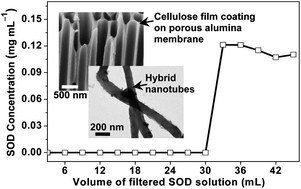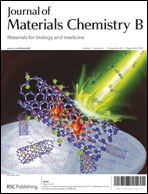Ultrathin cellulose film coating of porous alumina membranes for adsorption of superoxide dismutase†
Abstract
The non-toxic and biocompatible cellulose possesses nonspecific binding properties for many protein molecules. But its abundant inter- and intra-molecular hydrogen bonds induce spontaneous self-assembly of cellulose into a random fibrous morphology and cellulose film coating is usually just available for two-dimensional flat substrates, which severely limits its protein adsorption performance. In this study, direct self-assembly of an ultrathin cellulose film on hybrid polyelectrolyte multilayer pre-coated pore surfaces of an anodic aluminum oxide membrane was achieved through the dissolution and precipitation of cellulose from N-methylmorpholine oxide solution. Each pore channel surface pre-coated with a uniform polyelectrolyte hybrid layer (thickness ∼5.0 nm) was covered by a cellulose film (∼15.0 nm) consisting of dense cellulose nanoparticles with a diameter of 5.5 ± 1.4 nm. The three-dimensional porous structure of the aluminum oxide membrane was well-preserved and micrometre-long flexible nanotubes with an average outer diameter of ∼200 nm were obtained after further aluminum oxide template dissolution treatment in an acidic environment. Moreover, the cellulose film coated pore channel surfaces presented sufficient hydrogen bonds and exhibited a high adsorption capacity rate of ∼1.45 mg m−2 for superoxide dismutase. This facile cellulose deposition approach enabled ultrathin cellulose film coating on three-dimensional structured substrates for enhanced adsorption performance for protein molecules.


 Please wait while we load your content...
Please wait while we load your content...